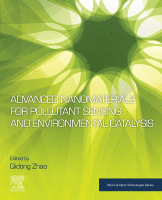Browse content
Table of contents
Actions for selected chapters
- Full text access
- Book chapterAbstract only
Chapter 1 - Hollow Micro- and Nanomaterials: Synthesis and Applications
Baojun Liu and Xia Hu
Pages 1-38 - Book chapterAbstract only
Chapter 2 - Noble Metal–Based Nanosensors for Environmental Detection
Wei Xiong, Pancras Ndokoye and Michael K.H. Leung
Pages 39-78 - Book chapterAbstract only
Chapter 3 - Semiconductor Nanocrystal–Based Nanosensors and Metal Ions Sensing
Jun Ke
Pages 79-117 - Book chapterAbstract only
Chapter 4 - Semiconductor Nanocrystals for Environmental Catalysis
Jun Ke
Pages 119-163 - Book chapterAbstract only
Chapter 5 - Nano-Gold Boosted Environmental Catalysis
Wei Xiong, Pancras Ndokoye and Michael K.H. Leung
Pages 165-202 - Book chapterAbstract only
Chapter 6 - Nanomaterials Developed for Removing Air Pollutants
Qidong Zhao, Xinyong Li, ... Huixin Xu
Pages 203-247 - Book chapterAbstract only
7 - Advanced Nanomaterials for Degrading Persistent Organic Pollutants
Qidong Zhao, Xiuming Zhao and Jingjing Cao
Pages 249-305 - Book chapterAbstract only
8 - Power Ready for Driving Catalysis and Sensing: Nanomaterials Designed for Renewable Energy Storage
Anmin Liu and Xuefeng Ren
Pages 307-346 - Book chapterAbstract only
9 - Colloidal Semiconductor Quantum Dot–Based Multicomponent Artificial System for Hydrogen Photogeneration
Ping Wang
Pages 347-377 - Book chapterAbstract only
Chapter 10 - Nanocarbon-Based Hybrids as Electrocatalysts for Hydrogen and Oxygen Evolution From Water Splitting
Muhammad Adnan Younis and Yang Hou
Pages 379-418 - Book chapterNo access
Index
Pages 419-429
About the book
Description
Advanced Nanomaterials for Pollutant Sensing and Environmental Catalysis presents the most recent advances and scientific discoveries in the fields of environmental protection and sensing with nanotechnology. The book's authors highlight recent advancements in how nanotechnology is being used to create more efficient pollution controls, with particular attention given to noble metal nanosensors, novel hollow micro-/nanostructures with innovative functions, and advanced nanocatalysts based on carbon materials for water splitting. Each chapter demonstrates the fundamentals of the technology, illustrating key concepts and highlighting the latest developments and challenges in these multi-disciplinary fields.
This book is a valuable resource for academic researchers, graduate students and R&D professionals in the fields of material science, chemistry, environmental science and nanotechnology.
Advanced Nanomaterials for Pollutant Sensing and Environmental Catalysis presents the most recent advances and scientific discoveries in the fields of environmental protection and sensing with nanotechnology. The book's authors highlight recent advancements in how nanotechnology is being used to create more efficient pollution controls, with particular attention given to noble metal nanosensors, novel hollow micro-/nanostructures with innovative functions, and advanced nanocatalysts based on carbon materials for water splitting. Each chapter demonstrates the fundamentals of the technology, illustrating key concepts and highlighting the latest developments and challenges in these multi-disciplinary fields.
This book is a valuable resource for academic researchers, graduate students and R&D professionals in the fields of material science, chemistry, environmental science and nanotechnology.
Key Features
- Presents the current state-of-the-art and covers the fundamentals and related technologies from a strong chemical, material and environmental engineering background
- Covers current trends and issues, including nontoxicity, efficiency of decomposition, and the sensitivity of nanomaterials used for sensing and environmental remediation
- Highlights the benefits and challenges of using nanomaterials to control pollution
- Presents the current state-of-the-art and covers the fundamentals and related technologies from a strong chemical, material and environmental engineering background
- Covers current trends and issues, including nontoxicity, efficiency of decomposition, and the sensitivity of nanomaterials used for sensing and environmental remediation
- Highlights the benefits and challenges of using nanomaterials to control pollution
Details
ISBN
978-0-12-814796-2
Language
English
Published
2020
Copyright
Copyright © 2020 Elsevier Inc. All rights reserved.
Imprint
Elsevier
